We’re currently living in the attention economy. Everywhere we turn as consumers, things are fighting for our attention. Colorful apps on our phones hit us with regular buzz notifications, enticing us back to their platform. Late-night talk show hosts, backed up by a jazzy band, give us a glimpse into what glitzy celebrities are really like. And how could you forget the many on-demand streaming services full of addictive series designed to hook us?
It’s difficult—actually, no, it’s impossible—to stay on top of everything. We simply don’t have enough time or attention.
Fortunately, there are ways that your market research team can ‘hack’ the attention economy. There are predictable patterns of consumer behavior that you can use to your advantage: times of the day, days of the week, and seasons of the year when your survey will have the best possible chance of success.
But what are they? Keep on reading to find out.
Timing: The Optimal Hour of the Day
In the attention economy, not all 24 hours are equal.
You need to be strategic about the hour of the day when you send out your survey invitations. One study from Zendesk suggested that you’re best off sending out invitations between 1–4 a.m. The explanation was that your email won’t get lost in the sauce—as soon as consumers wake up, it’ll be right there at the top of their inbox.
But we’ve also conducted some research of our own—and it turns out that the best time of day depends on the audience. For B2B surveys, sending out invitations on Monday morning or Monday afternoon (anywhere from 3–6 p.m.) seems to work best. Thursday and Friday afternoons (3–6 p.m.) also work well—but these results have to be taken with a pinch of salt. Very few surveys are sent out at these times so those results may be skewed and less statistically significant.
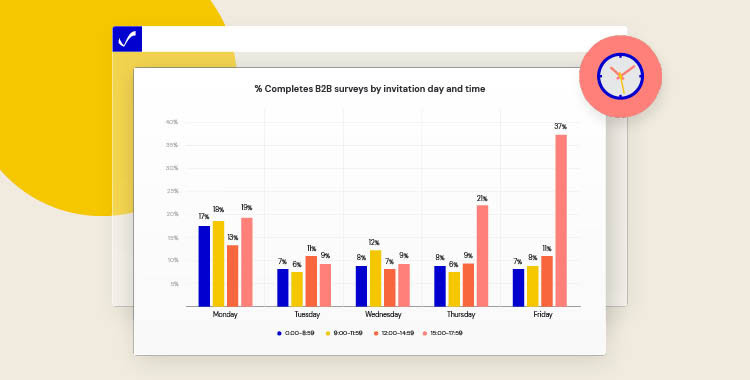
Source: CheckMarket
When it comes to B2C audiences, however, things are slightly different. Generally, you’ll receive higher response rates in the evening (6–9 p.m.) after people have finished work. Or, you could sidestep this entirely by sending out invitations over the weekend—in this case, Sundays from 3–6 p.m., and 9 p.m.–12 a.m., generally work best.
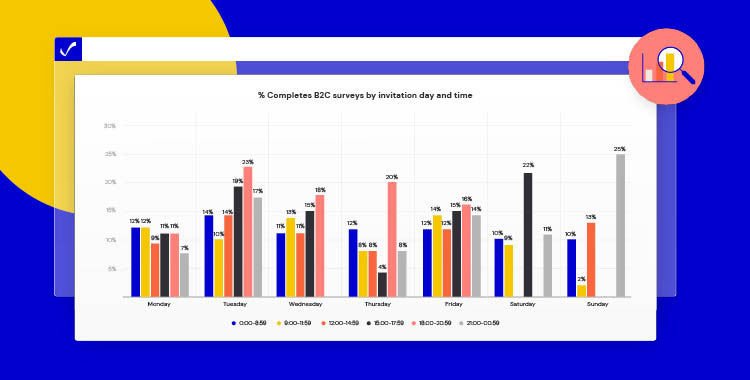
Source: CheckMarket
So, what should you do?
- Experiment with sending out invitations between 1–4 a.m. This strategy might work surprisingly well.
- B2B audiences: Monday mornings and Monday afternoons (3–6 a.m.) work well. Alternatively, test the waters by sending out invitations on Thursday and Friday afternoons.
- B2C audiences: On weekdays, 6–9 p.m. are your best bets. Sundays (3 –6 p.m. or 9 p.m. – 12 a.m.) might also generate positive results.
Timing: The Optimal Day of the Week
If you’re sending out invitations to B2B audiences then Monday is generally your best bet. However, note: this is especially true for short surveys. When it comes to long surveys, there’s really not much difference between any of the days of the week.
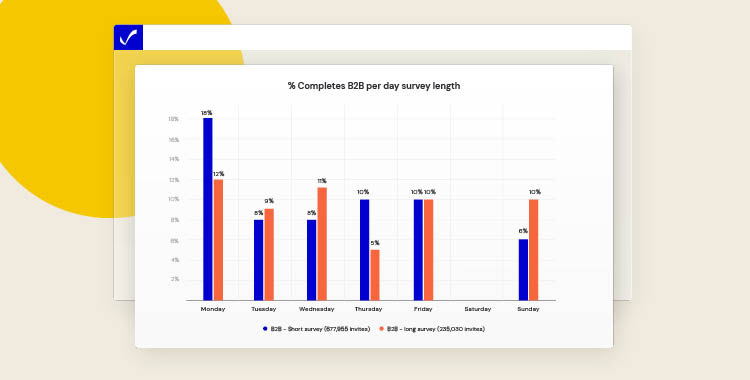
Source: CheckMarket
B2C audiences, on the other hand, have slightly more interesting—and complex—response patterns. Tuesday is clearly the best day for short surveys. However, for those that are on the long side, you might want to consider Wednesday or Friday.
But why is this?
It could be because people that work part-time often take Wednesdays or Fridays off—meaning they’ll be freer to complete long surveys.
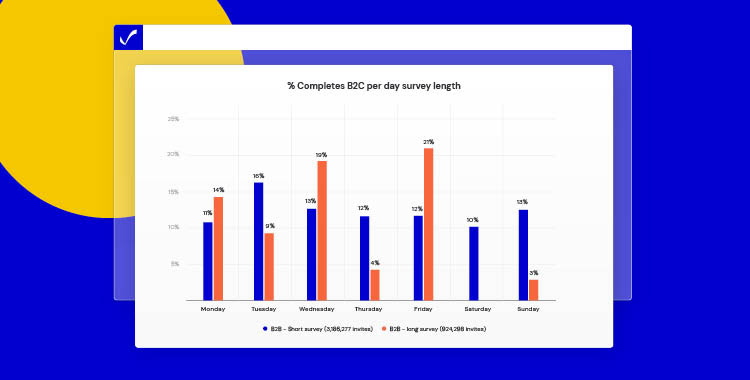
Source: CheckMarket
So, what should you do?
- Short surveys for a B2B audience: Mondays work best.
- Long surveys for a B2B audience: Any day of the week (aside from Thursday) should be fine.
- Short surveys for a B2C audience: Opt for Tuesday.
- Long surveys for a B2C audience: Generally Wednesday or Friday are your best options.
Timing: The Optimal Time of the Year
Unfortunately, there’s only a limited body of research out there on which times of the year deliver the most survey responses. We did, however, manage to find some research from Acuity, a housing satisfaction surveyor. This found that fall was the most popular time to send out surveys, with the highest response rates happening around January to April. Summer and December generally had lower response rates and were also the least popular times to send surveys.
This makes sense—during the summer, people might be away on vacation. Meanwhile, December is holiday season with kids home from school and families usually busy visiting one another.
So, what should you do?
- Consider sending out your most important surveys between January and April.
- Avoid holiday months particularly July or August and December.
Timing is Key
Maximizing survey responses is a fickle business. While many elements contribute to a survey’s performance, timing is perhaps one of the most crucial. Market researchers must take into account their audience, the length of their surveys, and of course, wider events that might be happening in people’s lives at the time.
Research shows that the time of day and day of the week are highly important—so keep these factors in mind at all times. Late winter to spring may be a good time of year, but avoid the middle of summer and December if possible.
Now, it’s up to you to carry out your own research and discover what works best for your surveys. Remember: every audience, and every individual within that audience, is different. The only way to find out the best times to send out surveys is to embrace an ongoing test-and-learn approach.
Key Takeaways
- For B2B audiences, Monday morning, and Monday, Thursday, and Friday afternoons all work well.
- Sending out invitations very early in the morning could also work by making your surveys the first thing respondents see when they wake up.
- B2C audiences prefer weekday mornings and Sunday afternoons and evenings.
- Long B2B surveys perform best on Mondays while shorter B2B surveys perform equally well on all other days (aside from Thursday).
- Tuesday is best for short B2C surveys while long surveys perform best on Wednesday or Friday.
- Late winter and spring might be the best seasons to get maximum responses—while summer and December surveys often get low response rates.
- Every audience is different—adopt a test-and-learn approach to optimize survey timing and maximize your results.

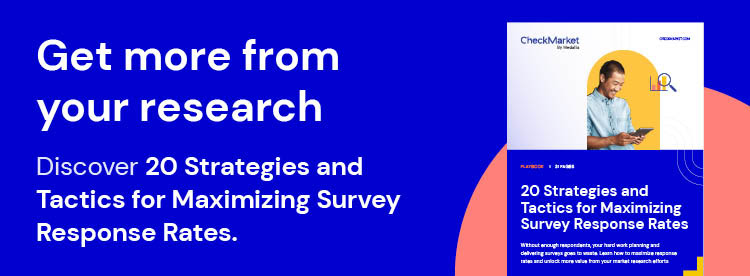
Laisser un commentaire